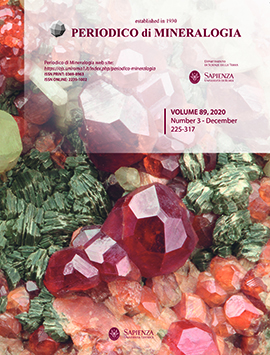Comment on “Petrogenesis of gabbroic rocks from the Malayer plutonic complex (Sanandaj-Sirjan zone, west Iran)”
Abstract
Esna-Ashari and Tiepolo (2020) provide new mineral chemistry data for some samples from the previously reported outcrop of mafic plutonic rocks from the northwestern part of the Malayer-Boroujerd Plutonic complex (MBPC in Deevsalar et al., 2017), which they referred to as MPC. In this paper, they proposed an oversimplified petrogenetic model, in which a quartz-dioritic parent magma with sanukitoid-like high-Mg andesite (HMA) signature – similar to that suggested by Esna-Ashari et al. (2016) for the Aligudarz Plutonic complex (APC), assumed to be generated by the reaction between boninitic ultramafic cumulates and a felsic melt – has produced the MPC gabbros.
This comment is not about the new data represented by the authors but, rather, refers to the data interpretation and the origin considered for these mafic rocks. We encountered several contradictions and oversimplifications in their interpretations in an attempt to force their data to support the petrogenetic model suggested for the APC.
The primary issue with their approach is that the limited number of nameless cumulate sample/s from the small outcrops of the Tangsaran hill (Figure 1a) have been used to explain the mafic magmatism in the MPC. We believe that, any interpretation and related conclusions in Esna-Ashari and Tiepolo (2020) must be limited to the cumulate rocks from the Tangsaran hill, not to the entire MPC.
Based upon our field and microscopic observations, three kinds of cumulate rocks have been identified in the Tangsaran hill (Deevsalar et al., 2017), which can be classified into two groups of olivine-bearing and olivine-free samples. Cumulus plagioclase is the dominant mineral phase that crystallized with either hornblende or hornblende + olivine ± clinopyroxene. Hornblende is present as cumulus (granular) phase and post-cumulate oikocrysts which the later one is a common interstitial phase in Tangsaran cumulates. The gradual transition between the plagioclase-dominated and Plagioclase + Olivine-dominated cumulate gabbros (Figure 1b) suggest the mineral accumulation and precipitation happened in the same magma chamber from a common parental melt. This is supported by similar major and trace element compositions of plagioclase and hornblende as common mineral phases in these rocks. However, limited outcrops in the Tangsaran hill hinder access to the entire cumulate layers but in comparison with other cumulate and non-cumulate gabbros across the MPC it may provide a screenshot of the magma chamber event.
The recalculation the compositions of melt in equilibrium with hornblende and clinopyroxene for the broader range of trace elements and using almost similar solid/liquid partition coefficients (Ds/l) to those of Esna-Ashari and Tiepolo (2020) on primitive mantle normalized plot reveals some meaningful compositional discrepancies (Figure 1c). It includes clear discrepancies among mineral equilibrium melts and their host rocks (i.e. Tangsaran cumulate gabbros) in addition to that of APC quartz diorites. Werts et al. (2020) reported several examples of hornblendes from different host plutonic rocks of high SiO2 variability (42-78 wt%), which are out of equilibrium with their host bulk-rock compositions. Most of the analyzed plutonic hornblendes in this study are in equilibrium with melts typically more silicic than host-rock compositions ascribed to the crystal accumulation and/or melt loss processes within the middle- to upper-crustal reservoirs. The composition of the residual melt in equilibrium with hornblende from the Tangsaran cumulates also approximates to that of highly evolved felsic magmas where SiO2 in calculated equilibrium melt varies between 63 to 73 wt% (±3.6 wt%, T: 950 ̊C, R2=0.86, Table 1; Putirka et al., 2016; Zhang et al., 2017). In contrast to what is argued in Esna-Ashari and Tiepolo (2020), the fluid-assisted metamorphic or magmatic reaction rim between olivine and plagioclase (i.e. corona) is a common feature in many gabbroic cumulates in arc settings and supports the magmatic evolution in the hydrous magma chamber rather than the interaction between evolved magma and cumulate assemblage (e.g., Whitney and McLelland, 1983; Joesten, 1986). The lack of textural and geochemical evidence of interaction between precipitated cumulate minerals and an evolved residual melt indicates melt extraction from the hydrous magma chamber during the open-system fractional crystallization process. In addition, the compositional discrepancies among hornblende equilibrium melt and host cumulate gabbro (Figure 1c) in Tangsaran hill is consistent with the segregation and accumulation of solid phases including clinopyroxene + plagioclase (+ olivine) ± ilmenite and apatite along with hornblende from the residual melt.


